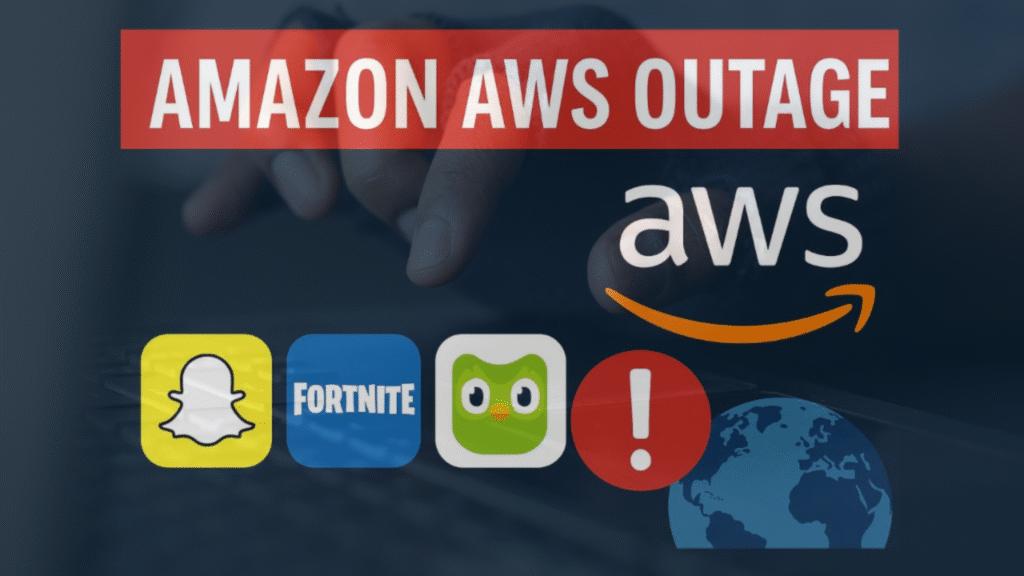On October 20, 2025, the biggest cloud computing company in the world, AWS, experienced a gigantic service breakdown that left widespread disruptions in many leading apps, websites, and online applications. The problem started early in the US morning hours and rapidly emerged worldwide, impacting users in nations like the United States, the United Kingdom, Australia, Germany, and the Netherlands.

The disruption affected some of the world’s most popular platforms like Snapchat, Fortnite, and Duolingo, as well as essential services like online banking, e-commerce, and digital communications. More than 8 million users experienced connectivity problems worldwide on Downdetector.
What Occurred During the Amazon AWS Outage?
The outage began at an early hour on 20 October when AWS suffered a severe connectivity breakdown in its US-EAST-1 data center, one of its most critical facilities. The cause of the issue was traced to an internal subsystem that is used for monitoring network load balancer health. The breakdown caused a chain reaction that impacted a vast array of services hosted on the platform.
Within a matter of hours, social media sites, gaming platforms, and big banks reported outages. Downdetector counted more than 8 million reports globally 1.9 million of which were in the US and over a million in the UK.
Services impacted included mainstream apps like Snapchat, Fortnite, and Duolingo, and platforms like Signal, Reddit, and Alexa voice services. Even critical financial platforms were hit with disruptions.
By mid-afternoon, AWS said it had “tracked down the source” of the issue and started slowing new launches of EC2 instances in order to stabilize service. The company also noted it was taking mitigation measures to assist in recovery on its network.
Impact on Users and Businesses
The AWS outage showed the extent to which modern society relies on a few cloud providers. Millions of users were hit by sudden interruption of their day-to-day activities from online education to digital communication and entertainment.
- Personal Users: Couldn’t access messaging apps, gaming platforms, and streaming services. Alexa and smart home integrations also became unavailable.
- Businesses: E-commerce transactions, online banking services, and cloud-hosted apps were disrupted. Delayed operations and customer service were reported by some businesses.
- Global Scale: Though the breakdown started in the US, its effects quickly spread across continents. Hundreds of thousands of disruptions were reported by the UK, Germany, the Netherlands, Australia and others .
This colossal outage raised once again concerns regarding worldwide dependence on a handful of cloud giants for essential internet infrastructure.
Amazon’s Reaction to the Outage
AWS responded to the outage early on during the day and offered regular updates about its status page.
- Confirmed that the issue was caused by an internal subsystem related to network load balancers.
- Throttled new launches of EC2 instances to reduce system pressure.
- Provided routine updates as recovery went on.
- Posted “meaningful signs of recovery” in a few hours.
- Stressed that the majority of API requests were increasingly succeeding as the backlog was removed.
By the night, most services had been restored by AWS, although some users still experienced delays.
Lessons of the AWS Outage
The international incident provided some important lessons for digital infrastructure and companies dependent on the cloud:
- Risks of Cloud Dependency: Dependence on few providers can cause enormous disruption once they experience problems.
- Business Continuity Planning: Businesses must have redundancy plans to keep operations going during downtime.
- Clear Communication: AWS’s frequent updates served to alleviate panic and confusion among users.
- Global Ripple Effects: A single technical glitch in a region can have an impact on millions of people all over the world.
- Cybersecurity Awareness: Experts cautioned that outages tend to provide cover for phishing and other Cyber-attacks, advising users to remain alert.
Market and Industry Reactions
Despite the enormous blackout, Amazon’s stock stayed firm. Analysts attributed this to trust in the company’s capacity to get rid of technical glitches rapidly and its dominance of the cloud market.
AWS now controls approximately 30% of the worldwide cloud market share, followed by competitors Microsoft Azure (20%) and Google Cloud (13%). This incident pointed out the centralization of digital power within the hands of a handful of entities.
Cybersecurity and IT professionals further indicated that mainstay infrastructure such as banking, communication, and e-commerce is now closely integrated with these providers, further enhancing the effects of even short-term outages.
Key Takeaways and Final Thoughts
The AWS outage on 20 October 2025 serves as a clear wake-up call for both enterprises and consumers, highlighting the growing vulnerability of global digital infrastructure. While cloud computing has revolutionized speed, scale, and flexibility, it also concentrates significant risk when so much traffic depends on a single provider.
For businesses, investing in multi-cloud strategies and stronger contingency planning can help safeguard operations during disruptions. For customers, awareness and preparedness can ease the impact and reduce panic when outages occur. And for industries and governments, this incident underscores the urgent need to diversify infrastructure to avoid over-reliance on one source.
Although AWS acted quickly to restore services, the sheer scale of this disruption demonstrates why resilience and transparency are essential in today’s interconnected world.